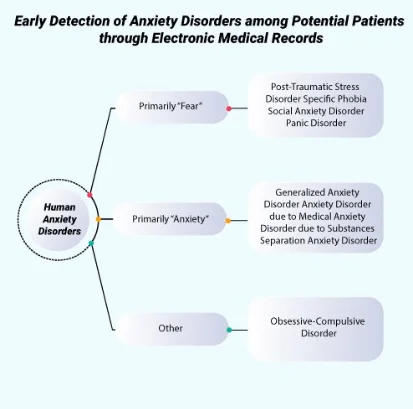Literature Review Sample Work
Early Detection of Anxiety Disorders among Potential Patients through Electronic Medical Records
Info: 2381 words Sample Literature Review
Published: 20th DEC 2022
Tagged: Medical & Healthcare
A successful methodology for data processing and archiving is cloud computing. Since user privacy is more crucial than ever, cloud data protection is getting better every day. The organization of data and the delivery of queries in the cloud must be secure and private in order for cloud-based technologies to be used more effectively and widely. In recent years, data collection has increased significantly as a result of the development of information technology (Agarkhed & Ashalatha R, 2017). The increase in Internet, social media, and multimedia consumers has made it necessary to manage enormous amounts of data in the cloud computing environment.
Symptoms, syndromal symptom combinations, frequency, severity, commencement, and duration of symptoms are all detected during a diagnostic evaluation, along with the level of associated anxiety and functional disability, developmental anomalies, and physical indicators. Separating anxiety disorders from the common psychological processes that affect everyone requires clinical skill. Children and teenagers who suffer from anxiety disorders are more prone to also experience headaches, asthma, digestive issues, and allergies, among other health issues (Sorbara et al., 2020).
The relationship between anxiety and physical diseases can either be coincidental—in which case the anxiety that develops prior to or following the physical sickness is brought on by something unrelated to the illness—or causative. Anxiety symptoms caused by physical pathology or physiology, anxiety symptoms caused by physical pathology or physiology, and anxiety brought on by physical sickness and/or therapy are a few examples of the latter. Regardless of the potential links, each condition, whether physical or psychological, is evaluated and treated individually (Janiri et al., 2020).
Changes in mood, attitude, and capacity to manage common difficulties or stress, seclusion from friends and interests, and other mental health issues are all too common everywhere in the world. Since it is impossible to deal with the effects of anyone close to suffering from a psychiatric illness, behavioral illnesses can have a big impact on people, their families, workplaces, and cultures. Machine learning will be used in the future to evaluate data and manage mental health, with a focus on depression (Garcia-Ceja et al., 2018). In many countries, mental diseases and their signs are poorly understood, and mental health does not receive the same amount of attention as physical health. Because depression impacts speech preparation and development, users can examine a person's vocal characteristics to determine whether they are depressed (Michelet et al., 2020).
In the United States and throughout the world, psychiatric disorders including depression and others pose serious public health risks. A person's connections, community, society, and communities all are impacted by untreated behavioral health concerns. The Random Forest algorithm is used to build a forecasting method that can be used to categorize children who are at risk of suffering a depression disorder as adults based on a range of input variables (Fuss, 2019). Anxiety is described as a worry about a potential issue related to physical tension and defensive action. People who suffer from anxiety disorders may make an effort to get away from circumstances that worsen or trigger their symptoms.
A future problem worry that is characterized by physical tension and defensive action is referred to as anxiety. Patients with anxiety disorders may feel obligated to stay away from situations that worsen or trigger their symptoms (American Psychiatric Association, 2021). Anxiety disorders include social anxiety disorder, agoraphobia, panic disorder, generalized anxiety disorder, and anxiety separation. These anxiety disorders are prevalent in adolescents and even some adults, however they are commonly misdiagnosed, delaying the start of therapy and interfering with the patients' day-to-day activities (Emmelkamp et al., 2020).

EMRs have a wealth of patient data, including biometric indicators based on historical information. If a pattern is looked at among persons who have particular diseases, different signals may be found. These patterns might not be immediately visible to the human eye, but they can be found by using machine learning techniques and the most recent data collection. Machine learning may accurately detect the existence of anxiety disorders in the EMR at an early stage (Delgadillo & Gonzalez Salas Duhne, 2020).
While therapy is the only alternative form of treatment for these anxiety disorders, they can be somewhat avoided in younger people. Electronic health records (EHRs) are widely used in healthcare systems, creating a huge and constantly growing pool of clinical data that has created new opportunities for population-based research (Rook et al., 2022). The need for large sample numbers, which has become a bottleneck in genetic research, may be overcome with the help of the connection of EHRs to bio specimens and genomic data in bio banks, in particular. The biggest barrier to using these resources is the need to demonstrate the veracity of phenotypes extracted from the electronic health record (Knowles & Olatunji, 2021).
As per the authors Smoller (2018) this is particularly difficult in the field of psychiatric genetic research because diagnosis is based on patient reports and clinician observations that might not be adequately documented in billing codes or narrative records. The use of EHR-based phenotyping in mental genetic research is the main topic of this review, which also examines the advantages and disadvantages of the method (Hyman et al., 2020). Increasing numbers of research have demonstrated that EHRs can be utilized to create diagnostic algorithms with high positive predictive value, particularly when structured data is supplemented by text mining methods. These methods allow for the semi-automated phenotyping required for extensive case-control studies (Batool-Anwar et al., 2020).
The authors Edwards et al., (2020) have used the regression technique, which has the potential to enhance accuracy much more than SVM. The study is additionally constrained by the fact that billing codes, rather than a clinical or standardized research diagnostic, are employed to look at administrative data. Diagnostic thresholds will fluctuate between doctors and circumstances, and there is a lack of uniformity in how diagnostics are made and reported. The fact that the conclusions are based solely on the findings of one province in a national survey may also limit their applicability. Additionally, neither the survey nor the administrative data sources had access to information on prescription drug use, which would have been useful in determining the presence of a mood or anxiety issue. Researchers were also unable to compare certain high-risk categories, such as migratory groups, populations that were homeless or institutionalized, and indigenous people who lived in indigenous villages, due to the small sample sizes and coverage available.
The researchers Manias et al., (2020) have utilized only less theoretical involvement frameworks. Future research will therefore be able to assess theoretical frameworks and determine whether and how patient engagement happens during interactions between healthcare professionals and patients. Future studies should examine how families use the EMR in conjunction with patients and healthcare professionals because families play a crucial role in helping patients with their medical requirements. An original method of observation that can offer perceptions on dynamic elements of patient contact is video ethnography, for instance. More attention should have been focused on urging patients to use the patient portal and encrypted messaging when dealing with patients who are prone to lack trust in using these kinds of technology. In order to help patients from low socioeconomic backgrounds use this technology, it should be used to determine their needs, such as low health literacy and language obstacles.
The researchers Bahji et al., (2020) have stated about the therapies for anxiety and anxiety disorders, it is important to remember that there are several important restrictions on their application. First, this meta-analysis considered a range of study durations and methods, such as randomized controlled trials, open-label studies, and quasi-experimental studies (ranging from one to 104 weeks). As a result, it is more challenging to draw a definite conclusion about the best treatment timings due to the fact that some trials are brief and others are extremely long. Furthermore, the accuracy of each participant's assessment is questionable given the smallest sample size of only 8 people. The sample sizes for the randomized controlled trials, which had this purpose, were so modest that there were only a total of 80 individuals in all five of them. Overall, the quality of the evidence was judged as being of low quality; very few studies were reliably randomized, controlled, or blinded.
The authors Salari et al., (2020) spoke about the EMR's ability to access data in a temporal manner, preserving the order in which patients' symptoms first appeared. Time series approaches are difficult to employ since visits are unpredictable; for example, a patient might see their doctor twice in a week and then go a year without scheduling another appointment. Recurrent neural networks, such as long short-term memory, are able to maintain event order without relying on time as a variable, but they only offer a limited amount of insight because they do not output which combinations of events are predictive. Linear regression, support vector machines, and random forests are a few examples of traditional Machine Learning techniques that are straightforward to define in terms of which features have the greatest influence on the output, but they do not, by default, take the time dimension into consideration.
2.1 Research gap
Research has demonstrated that mental health issues like depression and others frequently affect physical health in a substantial way. In recent years, artificial intelligence (AI) techniques have been created to assist professionals working in the mental health field, such as psychiatrist and counselors, in making judgments based on data provided by patients. Examples include social media activity, behavioral information, and medical history. In order to facilitate patients and their family’s choices through active verbal involvement, observational studies looking at how communication occurs during bedside encounters, ward rounds, and clinician handovers may be improved.
The best way to serve patients with complicated needs is to conduct future research that examines methods for fostering involvement through written communication using the patient portal and secured messaging (Su et al., 2020). Depressed people must actively participate in the use of the depression screening equipment that is now available. However, due to a lack of knowledge and the severity of the problem, a sizable portion of the population chooses not to seek expert assistance. A model that can identify signs of depression from conversational audio is required for such a gadget (Tasnim & Stroulia, 2019).
Anxiety is one of the psychological consequences of mental health that is both most prevalent and well-studied. The countless interactions a person has on social media and with their personal digital devices tends to accumulate data about their social relationships, which can then be conveniently analyzed for behavioral or mental health insights. A few number of methodological issues were held responsible for the inability to clearly and thoroughly detect their mental health. Utilizing social anxiety assessments and mental diagnostic procedures on larger samples of anxiety sufferers has proved to produce results that are noticeably less reliable in more recent study (Salari et al., 2020). In light of this, the suggested study encourages the achievement of effective and precise findings in the identification of the anxiety disorder via EHR.
References
American Psychiatric Association 2021. What Are Anxiety Disorders? 2021.
Bahji, A., Meyyappan, A.C. & Hawken, E.R. 2020. Efficacy and acceptability of cannabinoids for anxiety disorders in adults: A systematic review & meta-analysis. Journal of Psychiatric Research. (129). pp. 257–264.
Batool-Anwar, S., Omobomi, O.S. & Quan, S.F. 2020. Impact of the novel coronavirus disease on treatment adherence and sleep duration in patients with obstructive sleep apnea treated with positive airway pressure. Journal of Clinical Sleep Medicine. (16)11,. pp. 1917–1920.
Delgadillo, J. & Gonzalez Salas Duhne, P. 2020. Targeted prescription of cognitive–behavioral therapy versus person-centered counseling for depression using a machine learning approach. Journal of Consulting and Clinical Psychology. (88)1,. pp. 14–24.
Edwards, J., Thind, A., Stranges, S., Chiu, M. & Anderson, K.K. 2020. Concordance between health administrative data and survey‐derived diagnoses for mood and anxiety disorders. Acta Psychiatrica Scandinavica. (141)4,. pp. 385–395.
Emmelkamp, P.M.G., Meyerbröker, K. & Morina, N. 2020. Virtual Reality Therapy in Social Anxiety Disorder. Current Psychiatry Reports. (22)7,. pp. 32.
Fuss, A.A. 2019. The Prevention Of Depression: A Machine Learning Approach.
Garcia-Ceja, E., Riegler, M., Nordgreen, T., Jakobsen, P., Oedegaard, K.J. & Tørresen, J. 2018. Mental health monitoring with multimodal sensing and machine learning: A survey. Pervasive and Mobile Computing. (51). pp. 1–26
Hyman, S.L., Levy, S.E., Myers, S.M., Kuo, D.Z., Apkon, S., Davidson, L.F., Ellerbeck, K.A., Foster, J.E.A., Noritz, G.H., Leppert, M.O., Saunders, B.S., Stille, C., Yin, L., Weitzman, C.C., Childers, D.O., Levine, J.M., Peralta-Carcelen, A.M., Poon, J.K., Smith, P.J., Blum, N.J., Takayama, J.I., Baum, R., Voigt, R.G. & Bridgemohan, C. 2020. Identification, Evaluation, and Management of Children With Autism Spectrum Disorder. Pediatrics. (145)1,.
Janiri, D., Moser, D.A., Doucet, G.E., Luber, M.J., Rasgon, A., Lee, W.H., Murrough, J.W., Sani, G., Eickhoff, S.B. & Frangou, S. 2020. Shared Neural Phenotypes for Mood and Anxiety Disorders. JAMA Psychiatry. (77)2,. pp. 172.
Knowles, K.A. & Olatunji, B.O. 2021. Anxiety and safety behavior usage during the COVID-19 pandemic: The prospective role of contamination fear. Journal of Anxiety Disorders. (77). pp. 102323.
Manias, E., Bucknall, T., Wickramasinghe, N., Gray, K., Schaffer, J. & Rosenfeld, E. 2020. Patient and family engagement in communicating with electronic medical records in hospitals: A systematic review. International Journal of Medical Informatics. (134). pp. 104036.
Michelet, M., Lund, A., Strand, B.H., Engedal, K., Selbaek, G. & Bergh, S. 2020. Characteristics of patients assessed for cognitive decline in primary healthcare, compared to patients assessed in specialist healthcare. Scandinavian Journal of Primary Health Care. (38)2,. pp. 107–116.
Rook, L., Mazza, M.C., Lefter, I. & Brazier, F. 2022. Toward Linguistic Recognition of Generalized Anxiety Disorder. Frontiers in Digital Health. (4).
Salari, N., Hosseinian-Far, A., Jalali, R., Vaisi-Raygani, A., Rasoulpoor, S., Mohammadi, M., Rasoulpoor, S. & Khaledi-Paveh, B. 2020. Prevalence of stress, anxiety, depression among the general population during the COVID-19 pandemic: a systematic review and meta-analysis. Globalization and Health. (16)1,. pp. 57.
Smoller, J.W. 2018. The use of electronic health records for psychiatric phenotyping and genomics. American Journal of Medical Genetics Part B: Neuropsychiatric Genetics. (177)7,. pp. 601–612.
Sorbara, J.C., Chiniara, L.N., Thompson, S. & Palmert, M.R. 2020. Mental Health and Timing of Gender-Affirming Care. Pediatrics. (146)4,. pp. e20193600.
Su, C., Xu, Z., Pathak, J. & Wang, F. 2020. Deep learning in mental health outcome research a scoping review. Translational Psychiatry. (10)1,. pp. 116.
Tasnim, M. & Stroulia, E. 2019. Detecting Depression from Voice. In: pp. 472–478.




